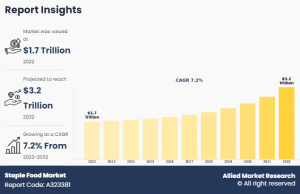Staple Food Market Poised for Robust Growth, Opportunities and Forecast
Innovations in agricultural technology, such as precision farming and advanced irrigation systems is projected to drive the global staple food market’s growth.
WILMINGTON, DE, UNITED STATES, October 28, 2025 /EINPresswire.com/ -- The global staple food industry size was generated $1.7 trillion in 2022, and is anticipated to generate $3.2 trillion by 2032, rising at a CAGR of 7.2% from 2023 to 2032.Consumers are increasingly interested in supporting local and community-based food systems. Companies that source staple foods from local farms or promote community-supported agriculture (CSA) can benefit from this trend, fostering consumer trust and reducing the carbon footprint of transportation.
Download PDF Brochure: https://www.alliedmarketresearch.com/request-sample/A323381
The rising demand for sustainably sourced and organic staple foods, innovations in agricultural technology, and the supportive government policies, including subsidies and agricultural incentives, are the factors expected to drive the growth of the global staple food market in the forecast period from 2023 to 2032. However, the stringent food safety standards and the adverse climate conditions may restrict market growth in the coming future. Contrarily, the rise of e-commerce and the increasing popularity of plant-based diets are expected to offer remunerative opportunities for expanding the staple food market during the forecast period.
A "staple food" refers to a primary or main food source that forms a major part of a community's diet. These foods are typically produced in large quantities and are the primary source of calories and nutrition for a region. They are often carbohydrates like rice, wheat, corn (maize), potatoes, or cassava, but can also include protein-rich foods like beans and lentils.
Staple foods are central to the culinary and cultural traditions of a region, providing the base for many dishes. They tend to be versatile, accessible, and relatively inexpensive, contributing significantly to the diet and food security of the population. For example, rice is a staple food in many Asian countries, maize is key in Latin America, and wheat-based products are common in Europe and North America.
Procure Complete Report (340 Pages PDF with Insights, Charts, Tables, and Figures) @ https://www.alliedmarketresearch.com/staple-food-market/purchase-options
Technological advancements in food processing, such as high-pressure processing and aseptic packaging, help extend the shelf life of staple foods while maintaining quality and safety. This enables broader distribution and reduces food waste. Precision agriculture uses data-driven technology, such as GPS, drones, and sensors, to optimize farming practices. This leads to increased crop yields, efficient resource use, and reduced waste, ultimately boosting staple food production.
Technologies like drip irrigation and automated sprinklers enhance water efficiency, allowing farmers to grow staple crops in arid regions or during periods of drought. This helps maintain a stable supply of staple foods. All these factors are anticipated to drive the staple food market share.
A staple diet heavily reliant on staple foods can lead to deficiencies in vitamins and minerals, as these foods often lack the variety of nutrients found in a diverse diet with fruits, vegetables, and proteins. Staple food markets can be volatile, with prices influenced by factors like weather, global trade, and geopolitical events. Sudden price increases can affect food security for vulnerable populations. The large-scale cultivation of staple crops often leads to deforestation, soil degradation, and loss of biodiversity. Intensive farming practices can deplete soil nutrients and require heavy use of chemical fertilizers and pesticides. All these factors are anticipated to restrain the staple food market growth.
Purchase Inquiry: https://www.alliedmarketresearch.com/purchase-enquiry/A323381
The Asia-Pacific staple food market size accounted for the largest share of 32.2% in 2022 and is predicted to continue its dominance and grow at the highest CAGR of 8.2% during the forecast period. Rapid population growth, urbanization, and increasing incomes are three major driving factors shaping market growth. As cities expand and populations soar, the demand for essential foods escalates. Urban consumers, with different dietary preferences, drive shifts in market dynamics, while rising incomes encourage diet diversification, yet staple foods maintain their pivotal role in traditional diets amidst economic growth.
Leading Players in the Staple Food Market:
Danone
Nestle
PepsiCo
JBS S.A.
Cargill
Mondelez
AB InBev
Coca-Cola
DIAGEO PLC
ADM Company
Trending Reports:
Cold Food Packaging Market: https://www.alliedmarketresearch.com/cold-food-packaging-market-A323763
Cocoa Fillings Market: https://www.alliedmarketresearch.com/cocoa-fillings-market-A323760
Margarine Market: https://www.alliedmarketresearch.com/margarine-market-A49222
David Correa
Allied Market Research
+ + + + + +1 800-792-5285
email us here
Visit us on social media:
LinkedIn
Facebook
YouTube
X
What Sets Us Apart ? - Allied Market Research
Legal Disclaimer:
EIN Presswire provides this news content "as is" without warranty of any kind. We do not accept any responsibility or liability for the accuracy, content, images, videos, licenses, completeness, legality, or reliability of the information contained in this article. If you have any complaints or copyright issues related to this article, kindly contact the author above.

